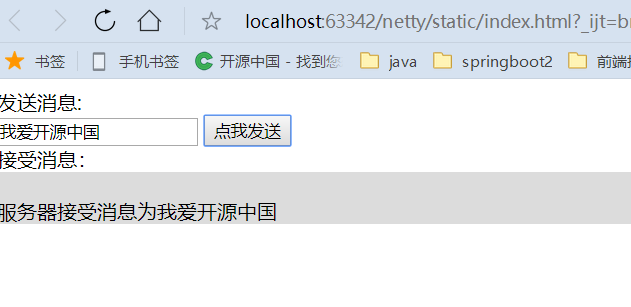Netty進階篇之websocket傳送訊息(8)
阿新 • • 發佈:2019-07-24
序言:Netty進階篇之簡單版websocket發訊息(7) 大概和下面的程式碼就成相似,如果不懂,可以看一下這篇部落格的詳細程式碼註釋內容
1、pom檔案
<dependency>
<groupId>io.netty</groupId>
<artifactId>netty-all</artifactId>
<version>4.1.25.Final</version>
</dependency>
2、index.html
<!DOCTYPE html>
<html>
<head>
<meta charset="utf-8" />
<title></title>
</head>
<body>
<div>傳送訊息:</div>
<input type="text" id="msgContent"/>
<input type="button" value="點我傳送" onclick="CHAT.chat()"/>
<div>接受訊息:</div>
<div id="receiveMsg" style="background-color: gainsboro;"></div>
<script type="application/javascript">
window.CHAT = {
socket: null,
init: function() {
if (window.WebSocket) {
CHAT.socket = new WebSocket("ws://192.168.31.160:8088/ws");
CHAT.socket.onopen = function() {
console.log("連線建立成功...");
},
CHAT.socket.onclose = function() {
console.log("連線關閉...");
},
CHAT.socket.onerror = function() {
console.log("發生錯誤...");
},
CHAT.socket.onmessage = function(e) {
console.log("接受到訊息:" + e.data);
var receiveMsg = document.getElementById("receiveMsg");
var html = receiveMsg.innerHTML;
receiveMsg.innerHTML = html + "<br/>" + e.data;
}
} else {
alert("瀏覽器不支援websocket協議...");
}
},
chat: function() {
var msg = document.getElementById("msgContent");
CHAT.socket.send(msg.value);
}
};
CHAT.init();
</script>
</body>
</html>3、main函式
import io.netty.bootstrap.ServerBootstrap;
import io.netty.channel.ChannelFuture;
import io.netty.channel.EventLoopGroup;
import io.netty.channel.nio.NioEventLoopGroup;
import io.netty.channel.socket.nio.NioServerSocketChannel;
public class WSServer {
public static void main(String[] args) throws Exception {
EventLoopGroup mainGroup = new NioEventLoopGroup();
EventLoopGroup subGroup = new NioEventLoopGroup();
try {
ServerBootstrap server = new ServerBootstrap();
server.group(mainGroup, subGroup)
.channel(NioServerSocketChannel.class)
.childHandler(new WSServerInitialzer());
ChannelFuture future = server.bind(8088).sync();
future.channel().closeFuture().sync();
} finally {
mainGroup.shutdownGracefully();
subGroup.shutdownGracefully();
}
}
}4、初始化類
import io.netty.channel.ChannelInitializer;
import io.netty.channel.ChannelPipeline;
import io.netty.channel.socket.SocketChannel;
import io.netty.handler.codec.http.HttpObjectAggregator;
import io.netty.handler.codec.http.HttpServerCodec;
import io.netty.handler.codec.http.websocketx.WebSocketServerProtocolHandler;
import io.netty.handler.stream.ChunkedWriteHandler;
public class WSServerInitialzer extends ChannelInitializer<SocketChannel> {
@Override
protected void initChannel(SocketChannel ch) throws Exception {
ChannelPipeline pipeline = ch.pipeline();
// websocket 基於http協議,所以要有http編解碼器
pipeline.addLast(new HttpServerCodec());
// 對寫大資料流的支援
pipeline.addLast(new ChunkedWriteHandler());
// 對httpMessage進行聚合,聚合成FullHttpRequest或FullHttpResponse
// 幾乎在netty中的程式設計,都會使用到此hanler
pipeline.addLast(new HttpObjectAggregator(1024*64));
// ====================== 以上是用於支援http協議 ======================
// ====================== 以下是支援httpWebsocket ======================
/**
* websocket 伺服器處理的協議,用於指定給客戶端連線訪問的路由 : /ws
* 本handler會幫你處理一些繁重的複雜的事
* 會幫你處理握手動作: handshaking(close, ping, pong) ping + pong = 心跳
* 對於websocket來講,都是以frames進行傳輸的,不同的資料型別對應的frames也不同
*/
pipeline.addLast(new WebSocketServerProtocolHandler("/ws"));
// 自定義的handler
pipeline.addLast(new ChatHandler());
}
}5、助手類
import io.netty.channel.Channel;
import io.netty.channel.ChannelHandlerContext;
import io.netty.channel.SimpleChannelInboundHandler;
import io.netty.channel.group.ChannelGroup;
import io.netty.channel.group.DefaultChannelGroup;
import io.netty.handler.codec.http.websocketx.TextWebSocketFrame;
import io.netty.util.concurrent.GlobalEventExecutor;
/**
*
* @Description: 處理訊息的handler
* TextWebSocketFrame: 在netty中,是用於為websocket專門處理文字的物件,frame是訊息的載體
*/
public class ChatHandler extends SimpleChannelInboundHandler<TextWebSocketFrame> {
// 用於記錄和管理所有客戶端的channle
private static ChannelGroup clients =
new DefaultChannelGroup(GlobalEventExecutor.INSTANCE);
@Override
protected void channelRead0(ChannelHandlerContext ctx, TextWebSocketFrame msg)
throws Exception {
// 獲取客戶端傳輸過來的訊息
String content = msg.text();
System.out.println("接受到的資料:" + content);
//類似於for迴圈
clients.writeAndFlush(
new TextWebSocketFrame(
"[伺服器在]" + LocalDateTime.now()
+ "接受到訊息, 訊息為:" + content));
}
/**
* 當客戶端連線服務端之後(開啟連線)
* 獲取客戶端的channle,並且放到ChannelGroup中去進行管理
*/
@Override
public void handlerAdded(ChannelHandlerContext ctx) throws Exception {
clients.add(ctx.channel());
}
@Override
public void handlerRemoved(ChannelHandlerContext ctx) throws Exception {
// 當觸發handlerRemoved,ChannelGroup會自動移除對應客戶端的channel
// clients.remove(ctx.channel());
System.out.println("客戶端斷開,channle對應的長id為:"
+ ctx.channel().id().asLongText());
System.out.println("客戶端斷開,channle對應的短id為:"
+ ctx.channel().id().asShortText());
}
}
6、測試
執行index.html
傳送訊息,如下server端返回訊息

